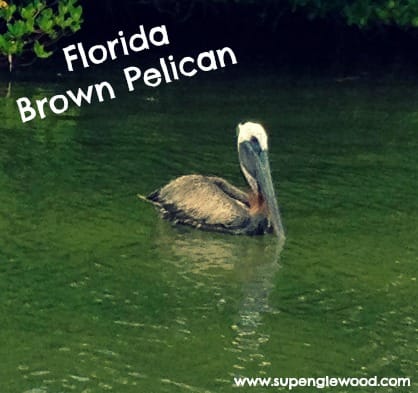Florida Brown Pelican: how we can all make a difference
Discover Florida’s Brown Pelican | a local favorite on Lemon Bay
Brown Pelicans have always been mesmerizing to watch, I remember being a little girl and fishing with my father under the Tom Adams bridge in Englewood, Florida. During those quiet moments waiting for fish, I would watch the pelican’s search for schools of fish, waiting to take their perfect opportunity to dive in and hunt for prey. I’ve always been captivated by displays of wildlife. Over the years, I have sadly witnessed a gradual decline in their population.
The Appearance of Brown Pelicans
Brown Pelicans are the smallest among the eight species of pelicans, measuring up to 54 inches long and weighing between 8 to 10 pounds. Their wingspan can stretch between 6.5 to 7.5 feet, making them a sight to behold as they glide over Florida’s waters. Their large bill, which can be up to 34.8 cm long, turns a reddish shade during breeding seasons. With pale yellow eyes, black legs, and feet, and a unique unfeathered black throat pouch, the brown pelican is a bird-watcher’s delight.
Florida brown pelican feeding patterns and hunting techniques
The Brown Pelican’s distinctive bill and expandable throat pouch are perfectly adapted for their feeding style. When they spot a fish from above they plunge dive scooping up both water and fish into their pouch. Interestingly enough they always tilt their head to the left to protect their esophagus. Then they tilt their heads to drain the water out, essentially using the pouch like a built-in net and swallow the fish. Although their pouch can hold a large pocket of water, their esophagus is relatively small, meaning they can only consume smaller bait fish. This adaptation ensures they thrive on the abundant small fish in their coastal habitats. These adaptations make them exceptional hunters perfectly suited to their coastal habitats.
From Endangered to Flourishing and then threatened again: The Conservation Journey
Brown Pelicans have faced numerous challenges over the years. Once considered endangered due to hunting and the effects of pesticides like DDT, they have made a remarkable comeback. Thanks to conservation efforts and legal protections such as the Migratory Bird Treaty Act of 1918 and the Audubon Society Brown Pelican Banding Project. Their populations have been steadily increasing since the late 20th century. Florida Fish and Wildlife Conservation (FWC) Commission’s regular surveys have also contributed to this positive trend.
The Threat of Fishing Litter
Despite their recovery, Brown Pelicans still face threats, particularly from fishing litter left on piers. Hooks and fishing lines can entangle these birds, leading to injuries or even death. It’s crucial for us to maintain clean fishing areas to ensure the safety of these native birds. This issue is pervasive in Southwest Florida, as the Skyway Fishing Pier is one of the most perilous places for the Brown Pelicans. Visitors can help protect these precious birds by eliminating fishing litter and properly disposing of gear and fish waste, like large bones. Joining local clean-up efforts also makes a big difference in protecting these local birds.
Skyway Fishing Pier Education Course – Protection for florida’s brown pelican
FWC has recently released an educational course for fishermen at the Skyway Fishing Pier. This required course is meant for anglers to better understand how they can prevent entanglement from brown pelicans and other shore birds. This course can be renewed annually, just like the required fishing license requirement. This course is required for anyone who fishes from the Skyway Fishing Pier State Park, including those who require fishing licenses, learn more on the FWC Educational Course Page.
The Impact of Human Interaction with brown pelicans
Another issue affecting Brown Pelicans is human feeding. While it may seem harmless, feeding alters their natural hunting habits and can make them dependent on human interaction, which is detrimental to their well-being. This behavior places them at increased risk of harm from people. While feeding pelicans might seem kind, it actually disruptions their natural hunting behaviors and makes them dependent on humans. Since they can only digest small fish bones, feeding them larger scrapes can actually cause them serious harm, and sometimes results in their death.
Paddle Boarding & Kayaking: A Peaceful Way to Observe pelicans & shorebirds
One of the most eco-friendly ways to observe Brown Pelicans is through paddle boarding and kayaking. These activities allow you to get close enough for a good view without disturbing their natural behavior. It’s a win-win situation: you get to experience the beauty of Florida’s coastal wildlife, and the pelicans get to continue their daily activities undisturbed.
Conservation Efforts and How You Can Help brown pelicans
Organizations like the Skyway Team Bird Rescue and Friends of The Pelicans have been pivotal in the conservation of Brown Pelicans. You can contribute by participating in local clean-up drives, educating others about the importance of not feeding these birds, and supporting local wildlife conservation programs.
importance of Preserving Brown Pelicans
The Brown Pelican’s survival through conservation is important not only for their species but also, for the greater coastal ecosystem in Florida and beyond. Through collective efforts in conservation and responsible wildlife observation, we can ensure that future generations will also get to experience Brown Pelicans and other shorebirds in the wild.
Ready to witness the Brown Pelican in lemon bay’s coastal habitat?
Book a paddle boarding or kayaking tour with us today. Learn more about how you can contribute to the ongoing efforts to protect these magnificent birds.



